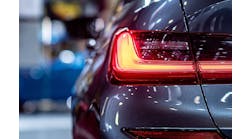Aug. 17, 2020—Tucked into a business park behind its Bloomington, Minn., location, LaMettry’s Collision’s ADAS calibration center looks more like a photo studio than a body shop, with tripods, carpenter’s triangles, and color mats lining the walls.
LaMettry’s president of operations Darrell Amberson says it was in 2018 that the MSO realized calibrating advanced driver-assistant systems following accidents was going to become a regular part of its business. In fact, he says, the lack of understanding of just how important calibration is after a crash—it can make the difference in whether the safety feature continues to function correctly, or not— is a big weakness in the collision industry.
Toyota, Amberson says, was the first to really press the issue by making such features standard, and the OE was the first for which the shop began offering calibrations. Lots of brands followed and now LaMettry’s takes on calibrations for any manufacturer whose vehicle shows up at the garage door, says mechanical operations manager Jason “Buck” Zeise.
After retrofitting existing spaces at other shops to perform calibrations, often requiring a dance of clearing the space needed, then keeping bodies out of it for extended periods of time, Amberson says LaMettry’s opted to put together the dedicated calibration center in Bloomington.
Already zoned for light industrial, Amberson says the garage is set up for ADAS calibrations and a few other lower-impact jobs, such as applying ClearGuard.
On a recent afternoon, a Ford F-150 was set up for a calibration demonstration, flanked by 30-foot black and white-checkered calibration mats supplied by the manufacturer. Lead tech Paul Bostel plugged a Dell laptop into the F-150’s OBD-II port and ran through Ford’s calibration set-up checklists—he’d already used laser levels to align the mats correctly with the truck’s axles.
Though some OEs support wireless calibration, Bostel says he prefers a literal connection to the vehicle on which he’s working to ensure everything works.
Amberson says the shop charges $345 per system calibrated. The F-150, says Bostel, has no fewer than four systems that can be calibrated — its front radar, front camera, rear camera and the Pro Trailer Backup Assist.
Each system calibration, assuming everything is set up correctly, Bostel says, takes two minutes or less. The knowledge and experience required to get to that level of efficiency he says, though, required months of trial and error.



